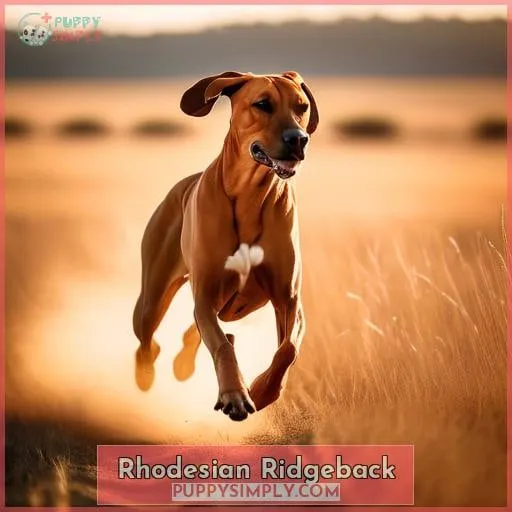This site is supported by our readers. We may earn a commission, at no cost to you, if you purchase through links.
 Imagine lacing up your sneakers, the sun just peeking over the horizon, and your four-legged friend wagging their tail, ready for the day’s adventure. You’re not just a runner; you’re a pack leader on a quest for fitness and freedom.
Imagine lacing up your sneakers, the sun just peeking over the horizon, and your four-legged friend wagging their tail, ready for the day’s adventure. You’re not just a runner; you’re a pack leader on a quest for fitness and freedom.
If you’re seeking a canine companion to share the trail, consider dog breeds that make good running partners. They’ll match your pace, share your endurance, and never shy away from a challenge.
Let’s find your perfect running mate and turn every jog into a journey.
Yes, certain dog breeds make excellent running companions, such as Weimaraners, Dalmatians, and Vizslas, known for their energy, stamina, and love for exercise. These breeds are ideal for active individuals seeking a furry partner for their runs.
Table Of Contents
- Key Takeaways
- Selecting a Running Companion
- Weimaraner Traits
- Dalmatian Characteristics
- Vizsla as a Partner
- German Shorthaired Pointer
- Rhodesian Ridgeback
- Border Collie Attributes
- Greyhound Advantages
- Labrador Retriever
- Jack Russell Terrier
- Frequently Asked Questions (FAQs)
- How do I introduce my dog to running if they’ve never done it before?
- What are the signs that my dog is overexerting themselves during a run?
- Can running on different surfaces affect my dog’s paws or joints?
- How do I ensure my dog stays hydrated and comfortable during runs in hot weather?
- What should I do if my dog shows little interest in running or struggles to keep up?
- Conclusion
Key Takeaways
-
Age and Physical Fitness Considerations: Young dogs with developing growth plates should not be subjected to excessive running, and their exercise intensity should be adjusted as they grow. Joint health is crucial, especially when running on high-impact surfaces, and a balanced diet is essential to support their energy needs without overburdening their developing bodies.
-
Running Conditions and Breed Suitability: Climate adaptation is important for breeds like the Labrador Retriever and Australian Cattle Dog, which need to stay hydrated. Gear and behavioral training can enhance safety, and recovery periods are important for breeds like the German Shorthaired Pointer and Belgian Malinois after running.
-
Surface and Environmental Adaptability: Different breeds are suited to various terrains; for example, Labradors are sturdy and can handle varied terrains, while Greyhounds may excel on smoother surfaces. A German Shepherd’s adaptability is beneficial when transitioning between different environments.
-
Temperature Tolerance and Breed Characteristics: Some breeds, like Weimaraners, can handle cold weather due to their muscular build and high energy levels, while others, such as Vizslas, are better suited for warmer climates. It’s important to assess a dog’s temperature tolerance to ensure their comfort and safety during runs.
Selecting a Running Companion
When selecting a running companion, it’s crucial to consider your dog’s age and physical fitness, as well as the specific conditions of your runs.
Different breeds excel in various environments and temperatures, so finding a match that suits both your lifestyle and your dog’s capabilities is key.
This ensures both you and your furry friend enjoy a healthy, happy running routine together.
Age and Physical Fitness
When you’re sizing up a potential furry friend to join you on your runs, it’s crucial to weigh in on their age and physical fitness. Young dogs, especially those under 18 months, may have growth plates that are still developing, which can be damaged by excessive running.
It’s essential to monitor their growth and adjust exercise intensity accordingly.
Diet considerations are also key to support their energy needs without overburdening their developing bodies. Joint health is another critical factor; high-impact surfaces can be tough on a dog’s joints, so choosing softer trails and monitoring for signs of discomfort is wise.
Breed compatibility with your running style matters too; some breeds have the endurance for long distances, while others are better suited for short, fast runs. Mental stimulation through training and play complements physical exercise and keeps your running dogs engaged and happy.
Always consult with a vet to tailor a dog exercise plan that promotes endurance and maintains the health of your active dogs.
Running Conditions
After considering your dog’s age and physical fitness, it’s crucial to evaluate the running conditions you’ll typically encounter, as these can significantly impact your choice of a running companion.
Consider climate adaptation, ensuring breeds like the Labrador Retriever and Australian Cattle Dog stay hydrated.
Gear recommendations and behavioral training enhance safety, while recovery periods support the German Shorthaired Pointer and Belgian Malinois’ health after running.
Surface and Environment
Moving from the broader considerations of running conditions, it’s crucial you also think about the surfaces and environment you’ll be running in with your dog. Trail running, urban pavement, park routes, coastal paths, and forest trails all present unique challenges and benefits for your running companions.
For instance, a Labrador’s sturdy build is well-suited for varied terrains, while the sleek Greyhound may excel on smoother, flatter surfaces. Consider a German Shepherd’s adaptability when transitioning between different environments.
Always ensure the chosen breed, like a robust Greyhound or an energetic Labrador, can handle the specific demands of your preferred running landscape.
Temperature Tolerance
Considering the importance of surface and environment in selecting a running companion, it’s equally crucial to assess a dog’s temperature tolerance to ensure their comfort and safety during runs. Your dog’s breed can greatly influence their ability to adapt to different temperatures.
For instance, Weimaraners, despite their short coat, can surprisingly handle cold weather due to their muscular build and high energy levels, which help them generate body heat.
Dalmatians and Border Collies, being medium and large warm-weather breeds, can tolerate cold down to zero degrees Fahrenheit while active, but may benefit from a coat in colder conditions.
Vizslas, originating from Hungary’s cold winters, can stay warm while active but may get cold during less vigorous activities or in wet conditions.
German Shorthaired Pointers have a moderate cold tolerance and may require protective clothing and a warm indoor environment after being outside in the cold.
Always monitor for signs of discomfort such as shivering or reluctance to stay outdoors, and consider your dog’s age, health, and coat quality when assessing their temperature adaptability.
Hot climate tips include providing plenty of water and shade, while cold weather precautions involve warm clothing and limiting time outside.
Seasonal running considerations are vital for breeds like the Beagle, Doberman Pinscher, American Foxhound, and Jack Russell Terrier, which vary in their temperature tolerance.
Weimaraner Traits
When considering a Weimaraner as your running companion, it’s essential to recognize their high energy and pace, alongside a muscular build that suits long, steady runs.
However, it’s crucial to exercise caution regarding their joints, especially during their younger years when they’re more susceptible to injury.
This breed’s robustness and stamina make them ideal for active runners, but their health needs should always be a priority.
Energy and Pace
Transitioning from general considerations for selecting a running companion, you’ll find that Weimaraners embody the ideal traits for active runners, boasting a blend of high energy and a muscular build that equips them for maintaining a brisk pace over long distances.
- Canine Endurance: Thrive in speed training with natural stamina.
- Pacing Techniques: Excel with consistent dog training for optimal pacing.
- Energy Boosters: High-energy breed, requiring minimal artificial stimulation.
- Weather Considerations: Adapt well to various climates, important for running companions.
- Muscular Build: Supports sustained speed and agility in dog breeds.
Muscular Build
One can’t help but admire the Weimaraner’s muscular build. This breed equips you with a running partner capable of impressive endurance and agility. Their strength training is innate, often resembling bodybuilding techniques in their robust play.
Integrating a Weimaraner into your fitness routines ensures a companion whose muscular endurance matches the vigor of breeds like the Rhodesian Ridgeback and English Springer Spaniel.
Exercise Caution for Joints
Weimaraners’ joints require careful attention during exercise to prevent long-term damage, especially while they’re still growing.
- Start with low-impact activities to build strength without straining joints.
- Gradually increase running distances, monitoring for signs of discomfort.
- Implement joint health precautions, like supplements and a balanced diet.
- After runs, check their joints for swelling or pain, ensuring their well-being.
Dalmatian Characteristics
When considering a Dalmatian as your running companion, it’s essential to recognize their unique blend of stamina and speed. This makes them exceptional partners for active lifestyles. Their sleek, muscular build and high energy levels equip them for both sprinting and endurance running.
With their love for exercise and ability to adapt to various running environments, Dalmatians stand out as loyal and energetic companions.
Stamina and Speed
Continuing from the muscular Weimaraner, you’ll find that Dalmatians match their stamina and bring remarkable speed to your runs. These dogs excel in speed training, with endurance tips rooted in their genetics.
They’re built for stamina building, thriving in various climates while keeping joint health in check. Dalmatians are the perfect partners for those seeking mastery and freedom in their active lifestyle.
Coat and Climate Adaptability
Dalmatians’ short, dense coats and unique spots not only define their appearance but also contribute significantly to their adaptability in various climates. Their fur requires minimal maintenance, yet it’s resilient against weather challenges.
Seasonal considerations are minimal, ensuring your runs are uninterrupted year-round, thanks to their excellent climate adaptability and straightforward fur care.
Vizsla as a Partner
When considering a Vizsla as your running partner, it’s essential to assess their suitability for your climate. Their sleek, short coat makes them well-adapted for warmer temperatures. However, they may require additional protection, such as insulated coats or sweaters, in colder climates.
Their impressive stamina ensures they can keep pace with you on long runs, making them ideal for active individuals. With a medium size that ranges between 45 to 65 pounds, Vizslas are robust enough to handle various running terrains while remaining agile.
Climate Suitability
After exploring the Dalmatian’s suitability for trail running, it’s important to note that the Vizsla, another active and athletic breed, is particularly well-adapted to warmer climates due to its short, sleek coat.
This breed’s climate adaptability and heat tolerance make it an ideal partner for runs in higher temperature ranges.
Cold weather considerations should be minimal for these robust companions.
Stamina and Size
Regarding the Vizsla as a running partner, their stamina and size make them exceptionally suited for runners looking for a medium-sized, robust companion.
With their sleek, red coat, Vizslas aren’t only visually striking but also built for endurance, capable of handling warmer climates without trouble.
Their eagerness and grace on the move, coupled with their impressive stamina, make them ideal for those who enjoy long-distance runs.
German Shorthaired Pointer
For those with an active lifestyle seeking a canine companion that matches their energy and enthusiasm for the outdoors, the German Shorthaired Pointer (GSP) stands out as an ideal choice.
Known for their athleticism and endurance, these dogs thrive on engaging in activities such as running, hiking, and swimming alongside their human counterparts.
Their love for the outdoors and need for vigorous exercise make them perfect partners for runners, ensuring both the dog and owner benefit from a healthy, active lifestyle.
Athleticism and Endurance
Building on the impressive stamina and climate adaptability of the Vizsla, you’ll find the German Shorthaired Pointer (GSP) embodies a similar spirit of athleticism and endurance, making them another prime choice for runners seeking a four-legged companion.
Their robust build requires attention to muscle conditioning and nutrition needs to sustain energy levels. Hydration importance can’t be overstated, especially after long runs, to aid in recovery and maintain a healthy heart rate.
| Aspect | GSP Focus | Runner’s Benefit |
|---|---|---|
| Muscle Conditioning | Strong legs | Sustained pace |
| Hydration Importance | Prevents overheating | Optimal performance |
| Recovery Strategies | Regular rest | Consistent training |
Outdoor Enthusiasm
For the German Shorthaired Pointer, an affinity for the outdoors isn’t just a preference—it’s a way of life, ensuring they’re at their happiest when engaging in activities under the open sky.
They excel in trail navigation and show remarkable weather resilience.
Benefiting from tailored hydration strategies, proper recovery practices, and selecting the right gear essentials are key to their well-being and performance.
Rhodesian Ridgeback
When considering a Rhodesian Ridgeback as your running partner, you’ll appreciate their strength and unwavering loyalty. These dogs are well-suited for long-distance runs due to their muscular build and endurance.
Moreover, their ability to tolerate heat makes them excellent companions for runs in warmer climates.
Strength and Loyalty
The German Shorthaired Pointer’s robust athleticism and love for the outdoors make it an excellent running partner, and in the same vein, the Rhodesian Ridgeback’s strength and loyalty offer a unique blend of companionship and endurance for runners.
- Muscle Structure: Built for long-distance runs
- Breed Loyalty: Unwavering companion on every trail
- Protective Instincts: Safeguards you with vigilance
- Training Techniques: Responds well to consistent guidance
- Behavioral Expectations: Balanced energy and obedience
Heat Tolerance
Among the best breeds for hot climates, you’ll find the Rhodesian Ridgeback, renowned for its ability to tolerate high temperatures with ease. Their adaptability is key, thriving through acclimatization and smart behaviors like shade seeking and water play.
Cooling vests can enhance their comfort, while their efficient breathing patterns help manage the heat.
| Feature | Benefit |
|---|---|
| Acclimatization | Thrives in hot weather |
| Shade Seeking | Avoids overheating |
| Water Play | Natural cooling |
| Cooling Vests | Enhanced comfort |
| Breathing Patterns | Efficient heat management |
Border Collie Attributes
Border Collies stand out as one of the most intelligent and energetic breeds, making them ideal running partners for active individuals. Their high exercise needs align perfectly with the lifestyle of avid runners, requiring at least 2 hours of vigorous activity daily.
This breed’s combination of smarts and stamina ensures they’re not just keeping pace but also enjoying every step of the journey with you.
Intelligence and Energy
Continuing from the Rhodesian Ridgeback’s notable strength and loyalty, Border Collies bring a different dimension to the table with their remarkable intelligence and boundless energy.
You’ll find their quick minds are as agile as their bodies, making them ideal for runners who enjoy mental engagement as much as physical exertion.
Their need for mental stimulation and behavioral enrichment meets the training challenges and companion compatibility sought by active owners.
Exercise Needs
Stamina is what you’ll need to match if you’re considering a Border Collie as your running companion, as they require a minimum of two hours of exercise daily, blending both physical and mental activities to stay content.
- Health benefits: Enhances cardiovascular fitness, joint health.
- Recovery strategies: Adequate rest, post-run massages.
- Nutrition advice: Balanced diet, hydration.
- Gear recommendations: Durable toys, agility equipment.
Greyhound Advantages
If you’re a runner seeking a canine companion that matches your pace yet doesn’t demand excessive daily exercise, the Greyhound might be your perfect match. Known for their incredible speed and active lifestyle, Greyhounds surprisingly require less exercise than you’d expect, needing only about an hour a day.
This blend of high-speed capability and moderate exercise needs makes them ideal for runners who appreciate both quick sprints and the convenience of shorter daily workouts.
Speed and Activity Level
The Border Collie is known for its remarkable intelligence and high energy levels.
The Greyhound’s advantages lie in its exceptional speed and moderate activity requirements.
As one of the premier endurance breeds, Greyhounds excel with shorter recovery periods, safeguarding their joint health.
Their breed agility keeps heart rates optimal, blending seamlessly into a runner’s lifestyle seeking mastery and freedom.
Lower Exercise Requirement
Transitioning from discussing their impressive speed and activity level, you’ll find that greyhounds surprisingly require less daily exercise than one might expect.
Their lower exercise needs still ensure health benefits, weight management, and mental stimulation. Breed variations and recovery periods are crucial for maintaining their well-being.
Labrador Retriever
If you’re considering a Labrador Retriever as your running partner, you’re in for a treat. Known for their friendly and trainable nature, Labradors make excellent companions for active lifestyles.
Their good-natured disposition ensures they’re not only great running partners but also adaptable to various activities, making every run enjoyable for both of you.
Friendly and Trainable
Often, Labrador Retrievers are consistently friendly and trainable, making them ideal running partners for you.
- Positive reinforcement enhances their natural eagerness to please, improving obedience.
- Socialization importance can’t be overstated; it ensures they’re well-behaved companions on runs.
- Behavioral training and obedience classes using consistent commands solidify their role as reliable, adaptable running buddies.
Good-Natured Companion
Building on the theme of trainability, Labradors stand out as exceptionally good-natured companions. They are not just trainable but also deeply enjoyable to spend time with on and off the running track.
Their personality traits foster breed compatibility with various lifestyles. This ensures they’re a perfect match for runners seeking a loyal friend who thrives on shared adventures and mutual growth.
Jack Russell Terrier
If you’re considering a Jack Russell Terrier as your running partner, their small size belies a high-energy nature that’s perfect for active runners.
These intelligent dogs are quick learners, making them highly trainable for consistent running routines.
With their spirited disposition, Jack Russells can transform your runs into engaging and lively workouts.
Small Size, High Energy
Companionship is a key element in the life of a Labrador Retriever. As we shift our focus to the Jack Russell Terrier, you’ll find that their compact size belies an immense reservoir of energy.
You’ll need to match their pace and enthusiasm on your runs, as they’re not only capable of keeping up but will often be raring to go even after you’ve finished. Their boundless vigor is perfect for urban agility, and with proper behavioral training, they excel.
Mindful diet considerations ensure their health benefits parallel your own.
Intelligence and Trainability
Transitioning from discussing the Jack Russell Terrier’s small size and high energy, we now delve into their intelligence and trainability. You’ll find that harnessing their sharp minds requires a blend of patience and consistency.
Their problem-solving skills, rapid learning speed, and impressive memory retention facilitate cognitive development.
This breed’s adaptive behavior makes them not just pets, but partners in your active lifestyle.
Frequently Asked Questions (FAQs)
How do I introduce my dog to running if they’ve never done it before?
Start with short running intervals during your walks. Gradually increase the run time. Monitor your dog’s response to ensure they are comfortable and healthy with this new activity.
What are the signs that my dog is overexerting themselves during a run?
Watch for signs like excessive panting, lagging, or reluctance to continue—your dog’s way of saying, Hey, this marathon session feels like a sprint to the vet!
Ensure they’re not overdoing the fun.
Can running on different surfaces affect my dog’s paws or joints?
Yes, running on different surfaces can indeed affect your dog’s paws and joints.
Hard surfaces like concrete and asphalt can be tough on cartilage and ligaments, potentially leading to joint inflammation, pain, and stiffness over time.
To protect your dog, opt for softer surfaces like grass or dirt trails, which are easier on their joints.
Additionally, extreme temperatures on surfaces can cause discomfort or injury, so consider the weather and use protective gear like booties if necessary.
Always monitor your dog for any signs of discomfort or injury after running.
How do I ensure my dog stays hydrated and comfortable during runs in hot weather?
Like a seasoned marathoner pacing for the long haul, ensure your dog’s hydration by offering water before, during, and after runs, especially in the heat.
Consider a collapsible bowl for convenience and monitor for signs of dehydration.
What should I do if my dog shows little interest in running or struggles to keep up?
If your dog is disinterested or struggling, consider their health, fitness, and preferences. Shorten runs and vary activities. Consult a vet to rule out underlying issues. They may prefer play to running.
Conclusion
As dawn’s light meets dusk’s shadow, so too does your journey with a four-legged friend begin. Whether you’re pacing through crisp mornings or enduring sun-soaked trails, the right dog breed will be your steadfast companion.
Embrace the shared strides with a breed that mirrors your rhythm and resilience. Remember, a dog that makes a good running companion isn’t just a pet; they’re a part of your pack, your heart, and every step of your adventure.
















